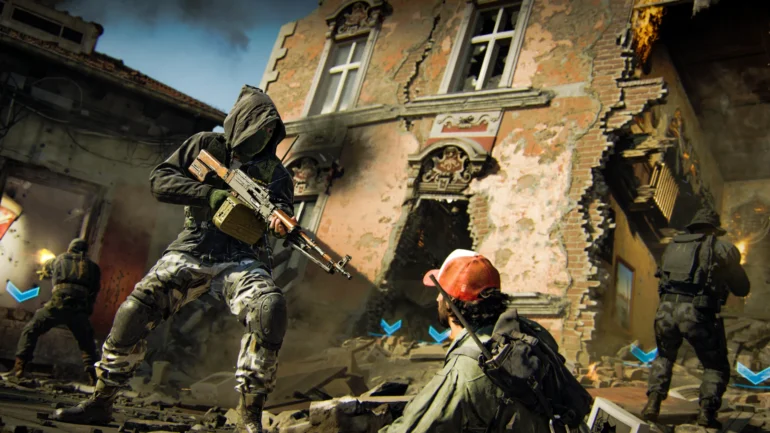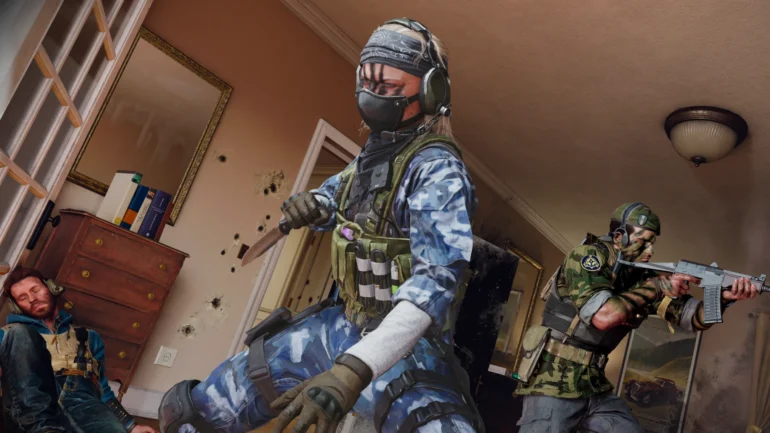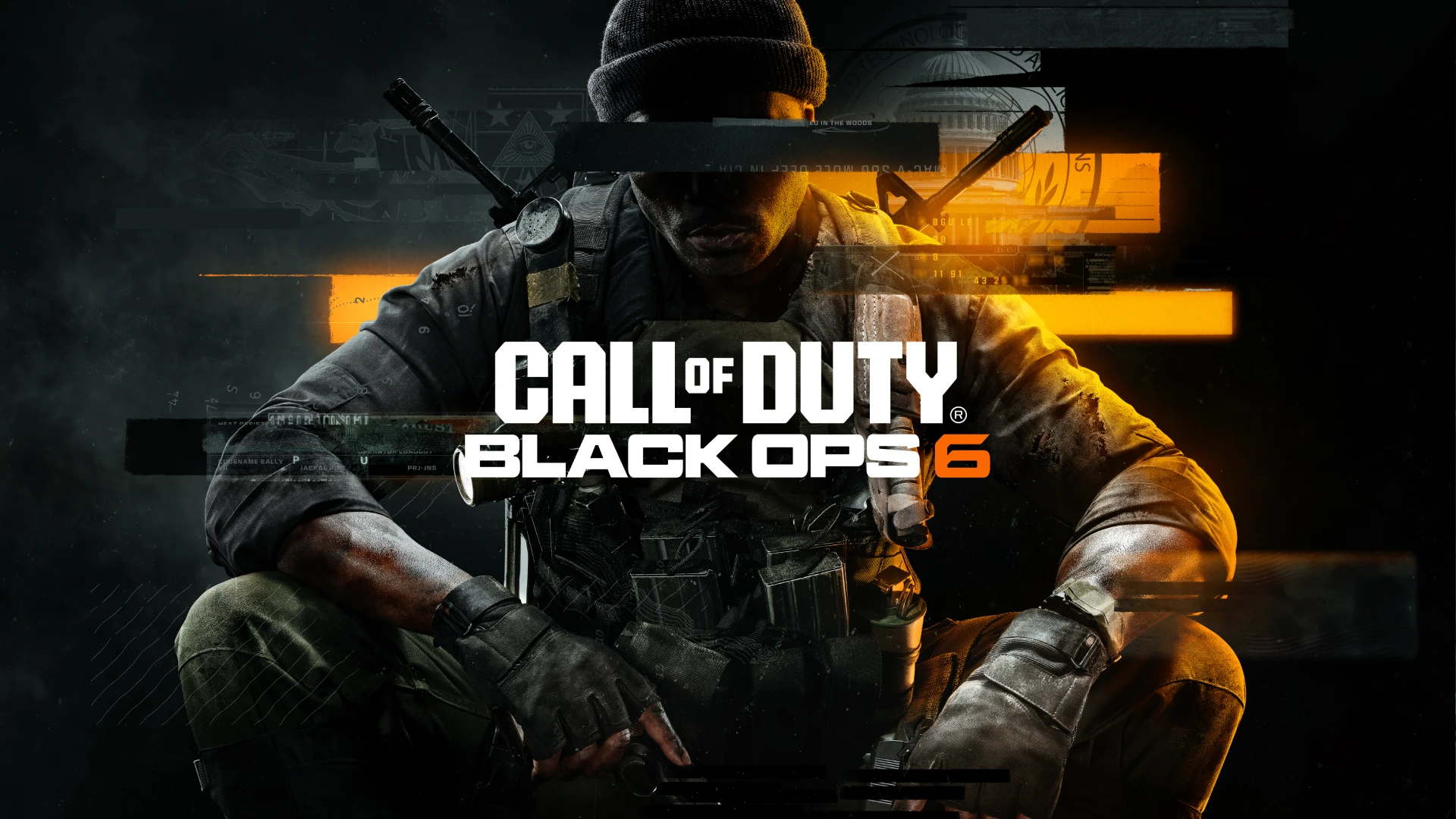Black Ops 6 exudes a level of grandeur that’s been rare in recent Call of Duty entries—bringing to mind the boldness of Infinite Warfare, Black Ops 3, and Advanced Warfare. It’s the first real outcome of Activision’s commitment to a three-year development cycle for the series’ core studios, and the results speak for themselves. Regardless of where you stand on those earlier entries, it’s undeniable that Black Ops 6 has elevated the series to a new level.
The sentiment was crystallized for me in a level about three-fourths of the way through the campaign as my team was undergoing a clandestine mission to retrieve documents from a safety deposit box in the lower levels of a glitzy foreign casino. Perspective switched from one character to the group’s leader Troy Marshall who needed to win his way into the high roller section to initiate a new leg of the heist.
With full control over Marshall, I wandered him through the casino’s grandiose lobby, its towering ceilings crafted from luminous stone. As Marshall moved further into the main casino floor, I was immersed in a bustling world filled with slot machines, craps tables, attentive waitstaff, patrons absorbed in animated conversations, a well-stocked bar, and even a vintage car that looked like it cost a tenth of the game’s entire budget. Though this lavish setting would later erupt into a brief shootout, the sheer level of detail floored me—it was almost indulgently meticulous.
Across the fabric of Black Ops 6’s campaign is an extravagance—a commitment to creating an immersive, sprawling world that feels real and engaging. This approach marks a stark departure from Modern Warfare III, whose campaign felt fragmented, a mishmash of familiar story beats scattered across chopped-up sections of the Warzone map. While Modern Warfare III tried to spark excitement with its promise of player freedom, its execution was rushed and uneven, as though Sledgehammer Games were working against the clock. In contrast, Black Ops 6 delivers on its ambitions with a level of polish and immersion that makes each mission feel truly impactful.
While budget isn’t everything, it plays a major role in shaping a game’s scope, cohesiveness, and overall polish. Even if you stripped away Black Ops 6’s multiplayer and Zombies modes, the campaign alone stands as proof that Raven Software—leading development instead of the usual Treyarch—had both the time and resources to create something exceptional. The result is a campaign that feels thoughtfully crafted, with every detail reinforcing its ambitious vision.
Apart from Advanced Warfare and Infinite Warfare, the Black Ops series has been the only Call of Duty branch to step away from the conventions of realistic, grounded warfare. From its inception, Treyarch’s entries have flirted with the fringes of post-World War II conflicts, exploring settings like Vietnam, the Cold War, and even a near-future world of augmented soldiers. Yet, even at its most grounded, Black Ops has delved into the psychological toll of combat and the morally ambiguous wars fought in the shadows—often orchestrated by the most clandestine corners of government.
Set in 1991, during Desert Storm and the final days of George H. Bush’s presidency, Black Ops 6 picks up the ever-evolving narrative that began with Black Ops 1 in 2010, continuing from the events of Black Ops Cold War (2020).
Like many Call of Duty campaigns, the heart of Black Ops 6 is understated and quiet. The story revolves around a series of brief, high-stakes missions that hint at a much larger threat, driving the player’s squad into action. From there, the narrative takes players across the globe, often accompanied by intense, explosive moments designed to spike the adrenaline.
While this year’s campaign doesn’t stray far from the familiar, what makes Raven’s work stand out is how it takes these well-trodden elements and twists them into something fresh and exhilarating. One of my favorite aspects of the campaign is how it introduces the main character, William “Case” Calderon, not only as a vehicle for the plot’s most thrilling moments but as a fully realized person, genuinely invested in the mission’s outcome and the nature of the challenges he faces.
Throughout Black Ops 6, players aren’t just selecting dialogue options—they can engage directly with teammates, asking about their backgrounds and motivations. Much of this interaction takes place at a safehouse called The Rook, an abandoned KGB mansion that serves as a central hub. Within The Rook, players can explore, uncovering text and audio logs that enrich the story and reveal hidden Easter eggs. While The Rook plays a pivotal role in the team’s fight against the paramilitary group Pantheon, it also serves as a guiding beacon for Raven’s vision, reflecting the heart of their approach to the game’s narrative.

Reflecting on Black Ops 2 and its dual narratives, where player decisions could shift the course of the story—often influencing which characters lived or died—Black Ops 6 takes a different route. While the game doesn’t offer that level of player-driven agency, Raven’s focus is on presenting Case not as a mere vessel for the player’s actions, but as a fully developed character with agency of his own. He actively engages with others, a significant shift for Call of Duty and a welcomed departure from the typical silent protagonist.
While it may not break new ground for the medium, Black Ops 6 represents a significant step for the Call of Duty franchise. Like any protagonist, Case is thrust into intense, life-or-death situations, often surviving by the narrowest of margins. However, the stakes here feel more personal. Players can directly engage with teammates, asking about their past traumas or checking on Woods’ emotional state before a mission—small moments that add depth to the narrative. Additionally, scattered across the campaign are cash drops that allow players to “upgrade” Case, improving his health, weapon handling, and equipment. These enhancements make Case not just a more powerful soldier, but a more compelling one, reflecting the game’s emphasis on character and growth.
These small but impactful additions bring much-needed nuance to a franchise often defined by spectacle, relying heavily on massive explosions and scripted set pieces. Surprisingly, Black Ops 6 feels relatively restrained when placed alongside other Call of Duty titles. In fact, much of the campaign can be approached in ways that align with the “black ops” ethos—players can choose between going in guns blazing or silently eliminating enemies. Take the casino mission, for instance, which begins with players taking out security as Case. From there, the perspective shifts to three other team members, each handling a separate objective, until the mission eventually culminates in an intense shootout.
In response to Modern Warfare III’s half-hearted attempt at “open” encounters, Raven intentionally crafted several missions with multiple main and side objectives. One notable mission takes place at a Bill Clinton campaign rally, where players must acquire an eye scan to infiltrate an underground facility. Players are given three distinct opportunities to complete this task, each with its own set of steps, allowing for a variety of approaches.
This concept is expanded further in a mission set in Iraq, where players enlist the help of SAS forces to raid one of Saddam Hussein’s palaces. Before the raid, Case and his team must disable three missile sites, a task that unfolds across a vast map. Here, players can drive between objectives, and when not in combat, they have the freedom to fast travel back to their vehicle or central base. The open environment encourages exploration, giving players a sense of autonomy in completing their objectives.
While a quick player could easily tackle the three missile sites and move forward, there are additional rewards for those who take the time to explore. Helping a downed Delta Force helicopter fend off enemy soldiers grants a scorestreak that calls in a powerful missile on cooldown. Destroying SAM sites unlocks a separate cooldown ability, and taking out Pantheon bases provides more insight into the overarching plot. Throughout all of this, any equipment or scorestreaks acquired can be used to simplify tasks like clearing missile sites and even brought along for the raid on Saddam’s palace.
The real triumph of Black Ops 6 isn’t just its status as one of the longest campaigns in Call of Duty history, nor is it solely the stunning visuals, exceptional sound design, or impressive voice acting and motion capture. What truly elevates Black Ops 6 is Raven’s willingness to break free from the established formula, taking bold risks that make this campaign one of the series’ most memorable.
Without giving away too much, Black Ops 6 delivers some genuinely surprising moments that made me laugh out loud with excitement. But it’s more than just an action-packed experience—it incorporates elements of horror and introspective themes that invite players to question the story unfolding before them. Typically in Call of Duty, I sometimes find myself simply trying to stop the villain without fully grasping the larger plot. Here, though, I followed nearly every twist and turn, with the intentionally cryptic story beats adding intrigue rather than confusion—at least until a later revelation. The over-the-top super-soldier action, while still present, felt more grounded and purposeful than ever.
About halfway through and again near the game’s climax, two standout missions break the mold of nearly every Call of Duty entry outside of Treyarch’s work. Here, Raven steps into bold territory, embracing the surrealism that Black Ops 3 tapped into during its mind-bending final act. These missions manage to transform themes of trauma and psychosis into gameplay, building an atmosphere thick with tension and an almost tangible unease, making the experience as haunting as it is memorable.
So, where could this leave Call of Duty moving forward? Predicting the future direction is tricky. Personally, I still see potential in modern settings, but they need the kind of creative spark that made the 2019 entry feel fresh without overplaying it. I was disappointed to learn that Sledgehammer’s concept for a follow-up to Advanced Warfare might be shelved. Still, Black Ops 6 shows that Raven has a unique vision, and I genuinely hope the franchise continues to evolve, reshaping familiar elements into something remarkable.
Though Black Ops 6 introduces one striking new feature to multiplayer, it largely upholds Call of Duty’s tried-and-true formula of finely tuned, fast-paced shooting.

The standout upgrade in Call of Duty’s multiplayer this year is “omnimovement”—a feature that takes movement in every direction to a new level. This system allows players to sprint forward, backward, sideways, and diagonally, while also enabling slides, dives, and full directional control even when prone. It’s a dense, dynamic upgrade that expands on the usual movement options, adding new layers to gameplay.
With its revamped movement mechanics, Black Ops 6 sets a new benchmark for speed and agility in the series, reminiscent of Infinite Warfare’s high energy. Although wall-running and boost jumps are a thing of the past, Black Ops 6 empowers players to charge ahead with continuous momentum, diving straight into the heat of battle.
In reality, this results in players taking bold chances—sliding and diving around corners in hopes of catching an opponent off guard or narrowly avoiding a fatal shot. Over the past two weeks, I’ve seen countless players leap out of windows, attempting to pull off daring stunts. Sometimes they pulled it off with style, other times they crashed and burned, only to become easy targets for a barrage of bullets.
The multiplayer combat carries a high-stakes intensity, driven by a quick time-to-kill and almost immediate respawns that keep both teams in constant conflict. However, despite getting familiar with the maps, I found that the 6v6 modes sometimes felt a bit too spacious. Even with the rapid movement, there were vast stretches of empty terrain where players could spend a lot of time searching for engagements—only to be taken out abruptly by a camper or sniper.
This problem is more pronounced on certain maps. Red Card, for example, often felt sparse, with small skirmishes erupting in the underground parking lot or stadium lobby, but not much happening on the periphery. Lowtown and Protocol boast dynamic central areas with plenty of action, but their outer edges really come to life only in Hardpoint or Control modes. While savvy players can find ways to sneak past and ambush opponents holed up in buildings, I do think some of these maps could benefit from trimming down the excess space.
A top-tier movement system pairs seamlessly with Call of Duty’s usual array of weapons. This year, it felt like players hadn’t quite settled on a dominant meta—or perhaps many were simply comfortable experimenting with a wider range of weapons. As is typical for the franchise, anyone familiar with Call of Duty’s pacing knows that finding your rhythm with one weapon comes easily, but stepping outside that comfort zone and adapting to something new may take a few matches and some time unlocking attachments.
While the perks in Black Ops 6 don’t stray too far from the norm, I do have to give credit for the introduction of specialization perks, which are unlocked by equipping three perks from a single category. These specializations aren’t game-breaking, but the Recon perk, which reveals enemies through walls upon respawn, removes kill indicators, and flashes the screen when targeted, is undeniably strong—and as of this review, it’s being nerfed.
In fact, that’s one of the notable elements in Black Ops 6 at the moment: with such a large player base, Treyarch will likely need to make ongoing tweaks for balance. I noticed this firsthand when Nuketown debuted—after a few hours of gameplay, I returned to find the control points had been expanded, reducing the map’s chaos. For long-time veterans, this constant refinement is simply part of the experience with a game of this scale.
The camo grind has grown into one of the more draining elements of the Call of Duty series over the years. By the time I reach Season 2 of a new release, I typically manage to snag a few gold camos before the monotony sets in. In Black Ops 6, the grind feels a bit less daunting, with the initial camo tier unlocked by simply landing headshots—effective, but unremarkable. The more specialized camos require different tasks, offering a bit more variety. Do I find myself immersed in it? Only in a perfect world where time isn’t in short supply.
I'm glad to see the Prestige system return to a more straightforward format. Once players hit level 55, they can Prestige, earning an unlock token for any weapon, perk, or equipment of their choice. From there, the leveling resets, offering new challenges and rewards as players climb through the prestige ranks. And for those dedicated enough, there's a massive grind with around a thousand levels to work through.

Completing the package this year is the mode that put Treyarch on the map: Zombies. Two maps are available: the quaint Americana town of Liberty Falls and the expansive Terminus map. Both bring a sense of familiarity, offering players the kind of classic Zombies experience they’ve come to expect.
Unless you’ve closely followed the ongoing narrative that threads through many of these entries, the background dialogue will likely fade into the noise as you’re dodging waves of zombies with your team. There’s no boarding up windows or doors in this mode; instead, the undead pour in from every possible corner. Eliminating enemies earns you points, which can be spent on weapons or unlocking barriers to access new areas of the map.
I always find myself hooked on Zombies mode. While it's not common to team up with random players who stick together and uncover all the secrets tied to each map's story, I still love the mode. Zombies offers a perfect extension of Call of Duty's exceptional gunplay, and Black Ops 6 stays true to that.
What sets Call of Duty: Black Ops 6 apart is that it doesn’t just hit that familiar rush of excitement you’d expect—it surpasses it. Treyarch has long proven their ability to capture the essence of what gets fans amped up, and both the Multiplayer and Zombies modes continue to demonstrate their mastery of this. But the standout here is Black Ops 6‘s campaign. It’s hands down one of the finest offerings from Call of Duty in recent years. Raven Software takes a familiar format and elevates it, blending dynamic gameplay with an engaging narrative that’s both fun and impactful.
Call of Duty: Black Ops 6 stands out as the best entry in years, though admitting it doesn’t feel particularly groundbreaking. Every year, the franchise nails its signature gunplay, but it’s up to each developer to bring something fresh to the table. Expect omnimovement to become a staple across future installments. Yet, if Black Ops 6 is any indication, Call of Duty‘s future is looking brighter than ever—especially if the same level of creativity and effort is applied to its campaigns moving forward.





